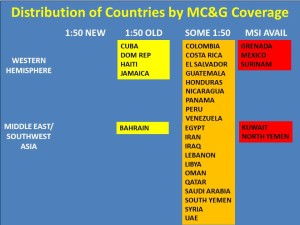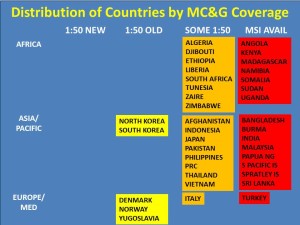Below is the GEOINT State of the World* as of 1990. With excellent intentions — and major advances in technology, third-party collection, and commercial methods — NGA's Map of the World has advanced tangibly and is to be praised. In that context, it would be useful to have an authoritative appraisal of precisely where we are today, in 2014, with respect to 1:50,000 combat charts, with contour lines and current cultural features, country by country, and with respect to 1:20:000 combat charts, city by city, port by port. This should include a deliberate recognition of many instances where GPS data and hand-held terminals are sufficient, along with a measured commitment to ensure that the infantry — 4% of the force, 80% of the casualties, 1% of the budget — is provided for in all the other instances where only a real map will do.


* This is actually only 67 countries and 2 island groups then of official interest to the US Marine Corps. The rest of the world at the time was in a similar state according to the US Special Operations Command J-2. MSI: Multispectral Imagery. MC&G (Mapping, Charting, & Geodesy) was put into the Foreign Intelligence Requirements and Capabilities Plan (FIRCAP) in 1992 at the request of the US Marine Corps, but the Marine Corps failed in its attempt to have the General Defense Intelligence Program (GDIP) mandate a geospatial attribute for every datum in every discipline — without this, near real time machine speed data fusion at the one klick level of granularity is not possible. Today we have Google Earth / Digital Globe (now at one quarter meter ground resolution) and many other wonderous capabilities including tactical drones and persistent surveillance options. An appraisal, to include a deliberate validation of multinational and joint government-commercial approaches to deficiency resolution that are vastly less expensive and much faster than unilateral system-high solutions, would be helpful to a variety of planning endeavors and real-world contingency responses.



